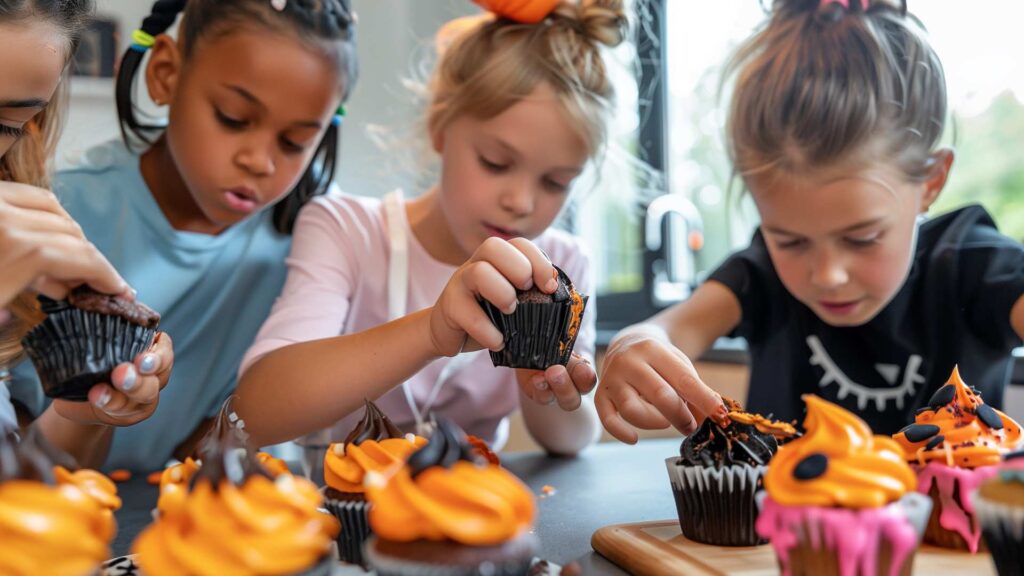Table of Contents
Autism and Halloween: Halloween, with its costumes, decorations, and endless variety of candy, is a beloved holiday for many. It’s a time for creativity, spooky fun, and community gatherings. However, for individuals with autism and their families, Halloween can present unique challenges.
The last thing families dealing with autism want is to turn the simulated horror of Halloween into real-life anxiety and terror. Sensory sensitivities, social interactions, and unfamiliar environments can be overwhelming for those on the spectrum. But with some preparation and understanding, Halloween can be an enjoyable and inclusive experience for everyone.
At ABA Centers of Florida, we provide opportunities for individuals with autism to express themselves fully and participate in life’s memorable events. Whether costume-making or trick-or-treating, neurodivergent individuals can own the holiday and add their personal touch. Florida is making strides to be an excellent state for autism care, and integrating autism awareness into our holidays can only grow the sense of camaraderie and inclusion that families feel.
Getting Halloween right is about preparation. To avoid unforeseen circumstances and unwanted adverse reactions from individuals with ASD, caretakers and family members should be ready with concrete plans for costumes, decorations, routes, and other considerations. If implemented in the month before the big day, these tips are our opportunity to help you have the best, stress-free day that goes off without a hitch.
This article will explore the intersection of autism and Halloween, discussing challenges and offering valuable tips to ensure individuals with autism can fully participate in and enjoy this festive holiday.
Understanding Autism

Autism, or Autism Spectrum Disorder (ASD), is a neurodevelopmental condition that affects how individuals perceive and interact with the world around them. No two individuals with autism will manifest the same traits, and the spectrum for expected behavior is broad. Common characteristics of autism include:
1. Sensory Sensitivities: Individuals with autism often have heightened sensory sensitivities, meaning they may be more sensitive to lights, sounds, textures, and smells. These stimuli can make Halloween decorations, costumes, and crowded parties overwhelming.
2. Communication Challenges: Many individuals with autism may have difficulty with verbal and non-verbal communication, making social interactions and understanding the nuances of Halloween traditions more challenging. For example, they may be unaware of the expectation only to take one piece of candy from a bowl or how to appropriately engage with individuals on the street who may be trying to scare them as a joke.
3. Routines and Predictability: Routines are essential for many individuals with autism. The novelty of Halloween events can be stressful, as it disrupts their preferences and expectations for the day.
4. Special Interests: People with autism often have intense interests in specific topics. Some may have a deep fascination with Halloween-related themes, which can create a positive experience.
5. Social Interaction Difficulties: Engaging in social activities, such as trick-or-treating, attending parties, or participating in group activities, can be challenging for individuals with autism who struggle with social interactions.
With these unique characteristics in mind, let’s explore how to make Halloween a more enjoyable experience for individuals with autism.
Tips for an Autism-Friendly Halloween
1. Sensory-Friendly Costumes
Many individuals with autism have sensory sensitivities, so choosing a comfortable and sensory-friendly costume is crucial. Here are some tips:
- Opt for soft, breathable fabrics that won’t itch or irritate the skin.
- Avoid costumes with tight elastics or tags that may cause discomfort.
- Consider clothing from the individual’s everyday wardrobe if they have texture preferences.
- If a mask is part of the costume, ensure it’s comfortable and doesn’t obstruct vision or breathing.
- Factor in their particular interest. If there is a character they specifically enjoy, theming costumes or parties around this interest will make Halloween immensely enjoyable.
2. Practice Costume Familiarity
Introduce the costume to the individual well in advance of Halloween night. Allow them to wear it briefly to get used to the sensation. Gradual exposure can help with sensory sensitivities and discomfort.
3. Social Stories or Visual Schedules
Individuals with autism don’t enjoy being blindsided by events. The new stimuli they encounter can be the cause of much anxiety. Therefore, it is essential to give them a strong familiarity with Halloween and its expectations before the holiday’s date. Create a visual schedule or social story about Halloween to prepare the individual for what to expect.
Include pictures or drawings of costumes, trick-or-treating, and other Halloween activities. Consider telling them about your experiences with Halloween and the fun you had. These social and visual aids can reduce problems by providing predictability.
4. Choose Autism-Friendly Events
Look for autism-friendly Halloween events in your community. These events often offer sensory-friendly activities, quiet spaces, and understanding staff. If none are available, consider organizing a small, private gathering with close friends and family who understand the individual’s needs.
5. Decorate Mindfully
Halloween decorations can be visually and audibly overwhelming. Consider decorating the home with the individual’s sensory sensitivities in mind:
- Use soft, dim lighting instead of bright, flashing lights. Considering the holiday’s ghoulish themes, no one will begrudge you for turning the lights low.
- Limit or avoid noisy decorations like animatronics or loud music.
- Allow the individual to help decorate at their own pace to create a sense of ownership and comfort. Take them along for your decoration shopping and see what they like. This event is another opportunity to incorporate their preferred interests and make them feel safe.
6. Plan a Sensory-Friendly Costume Parade
Invite a few close friends or neighbors for a sensory-friendly costume parade. This planning method will allow you to speak to friends and family about autism so everyone is on the same page. A controlled environment can provide a less overwhelming alternative to traditional trick-or-treating, allowing the individual to show off their costume and enjoy the festive spirit.
7. Practice Trick-or-Treating
Before Halloween night, practice trick-or-treating in your own home. Have family members or friends dress up as characters and practice giving and receiving candy. This rehearsal can make the actual event more emotionally manageable.
8. Be Mindful of Dietary Restrictions

Research indicates that individuals on the spectrum suffer from gastrointestinal problems at higher rates. They are 7% more likely to have food allergies, and compounding this challenge, many are picky eaters with strong aversions to particular foods. Before trick-or-treating or attending parties, familiarize yourself with what typical treats contain. Does a Snickers have nuts? Does dark chocolate have dairy? Consider communicating these restrictions to neighbors and hosts to ensure suitable treats are available.
9. Offer Choices
Individuals with autism have a unique way of seeing the world that may surprise you. Empower them by offering choices throughout the Halloween celebration. Allow them to choose which activities to participate in, what treats to accept, and how long they want to engage in Halloween-related activities. They might create new Halloween traditions that the whole family will enjoy.
10. Create a Safe Space
Designate a quiet, comfortable space within your home where the individual can retreat if they become overwhelmed. Fill this space with familiar objects and sensory tools like weighted blankets or fidget toys. Clarify that they can ask for a break or go to their comfort zone without repercussion if overwhelmed.
11. Consider Alternative Celebrations
If traditional Halloween activities prove too overwhelming, consider alternative celebrations such as a themed movie night or a cozy evening with a special treat. Tailoring the festival to the individual’s preferences can ensure a positive experience.
Autism and Halloween: How ABA Centers of Florida Can Help
Halloween can be a delightful and inclusive holiday for individuals with autism when families and communities take the time to understand their unique needs and sensitivities. ABA Centers of Florida is at the forefront of autism awareness and advocacy, helping individuals with autism participate in this beloved tradition while promoting a more inclusive and accepting society where everyone can celebrate together, regardless of their differences.
We offer the highest quality Applied Behavior Analysis (ABA), the best autism therapy, with decades of evidence showing better outcomes and personal growth. The main principle of ABA is positive reinforcement, helping those with ASD learn by rewarding them with the things they love the most. Given time and compassion, they will acquire skills that help them communicate, succeed, and be independent.
Call us at 772-773-1975 or message our website for a free consultation to learn more about how we can support your family and create a brighter, more inclusive future for everyone this Halloween.








